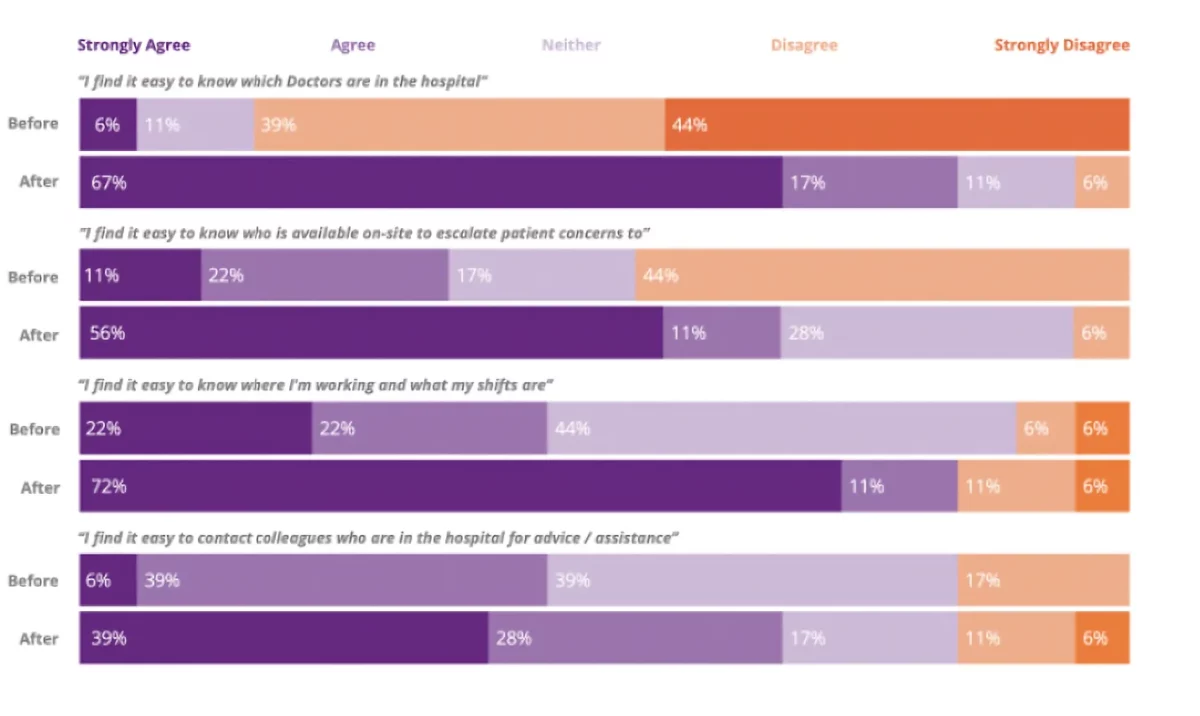Introduction
In the face of uncertainty during the Covid-19 pandemic, the NHS unleashed its potential for true innovation, speeding up procurements and adapting to new ways of working. With no time to spare, organisations rallied to meet the needs of patients and their families, whilst supporting staff through the most challenging time of their careers.
As one of the largest hospital trusts in the South-East providing emergency services, Buckinghamshire Healthcare NHS Trust (BHT) was at the forefront of the Covid-19 response within the local community – and it did this, despite years of recruitment challenges, particularly within Accident and Emergency.
The reason for the recruitment problems is tied to Buckinghamshire’s close proximity to London where house prices are historically considered to be high. With no London weighting to call upon, making the move can be difficult, and has forced many medical professionals to seek alternative career incentives outside of Buckinghamshire, and even abroad. This severely impacted on capacity and left the Trust little choice but to increase its spending on temporary and locum staffing.

About Buckinghamshire Healthcare NHS Trust.
Buckinghamshire Healthcare NHS Trust (BHT) is an integrated provider of acute hospital and community services for people living in Buckinghamshire as well as some people living across the borders in surrounding counties. We provide care to over half a million patients every year in our hospitals, community settings and in people’s own homes. Our vision is to provide outstanding care, create healthy communities and make a BHT a great place to work.
Download Buckinghamshire Healthcare Case Study (9.69 MB)

Challenges
-
Covid 19 Meant More Redeployment of Doctors
The workforce challenges at BHT were further magnified during the early stages of the Covid-19 pandemic. With the need to redeploy doctors across various parts of the hospital to manage self-isolation and sickness levels, it became apparent that the current manual rostering practices were insufficient.
-
Manual spreadsheets unable to cope with continuous changes
Medical rotas at BHT were formerly managed on spreadsheets which was neither reliable for recording changes to shift patterns or monitoring absences. At the point when sickness levels had increased dramatically, it meant that the Trust had no global view of where doctors were deployed.
-
Trainees report unequal deployment
Trainees also reported unequal deployment which consequentially impacted on workload and morale. It was clear that a prompt solution was needed.
-
Underlying recruitment issues
London property and rental prices but with no London weighting no London weighting to has severely impacted recruitment and left the Trust little choice but to increase its spending on temporary and locum staffing.

Solution
The e-rostering and workforce management platform – HealthRota, had previously been reviewed by the Trust as a solution that could solve its deployment challenges. It offered BHT a low-cost solution with limited contractual tie-in and was therefore quickly approved by Trust executives, clinical leaders, and trainees as part of the Covid-19 crisis response.
The HealthRota team worked with the Trust to complete the implementation within three days, enabling the rotas for the Division of Integrated Medicine, including all on-call rotas to be moved on to the platform. Within two weeks, staff had access to their rotas and could also view the availability of the wider medical team. Within one month, 95% of the Division’s junior doctors were using the HealthRota platform.
Having a mobile app that actually works for juniors makes a huge difference to how they plan their working lives.
Dr Mark Johnson, Board Affiliate & Internal Medicine Trainee
Results
Since the implementation in 2020, HealthRota has allowed doctors, managers, and administrators to easily see where the workforce is deployed in real time using desktop and mobile devices. Rota coordinators can flex the rotas to meet the real-time needs of patients and individual departments. All sickness and absence is immediately updated and for the first time, BHT has objective reporting data on safety to help demonstrate the need for substantive staffing increases as part of BHT’s wider recruitment plans.
Furthermore, medical teams across A&E have a more accessible way to see their rotas, book leave and know in advance when a shift change has occurred. Moving forward, the Division is allowing junior doctors to specify the weekends they do not want to work in advance which aims to improve morale, reduce levels of burnout and create a more positive working environment.
Dr Mark Johnson, Board Affiliate & Internal Medicine Trainee, led the implementation at BHT and said: “Having a mobile app that actually works for juniors makes a huge difference to how they plan their working lives. There is clear visibility of where your colleagues are working and allows the rota team to safe staffing across our working areas.”
Feedback survey results
In 2021, a year after the initial implementation, a survey was conducted to understand the effectiveness of the HealthRota solution. Feedback was determined through the rota coordinators, along with before and after questionnaires from clinicians using the platform.
The survey showed that 84% of medical trainees ‘strongly agree’ or ‘agree’ when asked if they found it easy to know which doctors are in the hospital. Prior to HealthRota, this figure was just 17%.
Furthermore, 95% find it easier to know who is available to escalate patients’ concerns to, compared to only 50% a year before. Overall, staff reported positive changes in the rostering practices which has led to improvements in workload, morale, and peer-to-peer communication.

Levels of attainment
In 2019, NHS England set out five ‘levels of attainment’ (LoA) for implementing e-rostering systems to help NHS trusts benchmark their progress for adopting the software. The levels of attainment are sequential, ranging from level 0 to 4. The supporting standards state that each level must be achieved before the next level can be met. BHT reports its progress annually and is currently achieving level 1 and level 2 for its medical staff. Most of the higher LoA require enhanced reporting and attainment of those is part of BHT’s long-term objectives.

Conclusion
Despite the difficulties that Covid-19 presented, Dr Johnson and the medical e-rostering team were able to use HealthRota to streamline the erostering practices at BHT. Innovation in erostering along with optimised deployment processes has improved the working lives of doctors, ensured patient safety, and contributed to reductions in locum spend.
Against the challenges of staff sickness rates more than doubling due to the pandemic, locum costs have continued to stabilise since the implementation. The Trust intends is to use HealthRota to help reduce locum costs further over the coming years.
As part of its wider implementation, Buckinghamshire Healthcare NHS Trust plans to roll out features such as annualisation, flexible rostering and swap requests for medical trainees to further improve morale, increase flexibility, and as a mechanism to attract new medical professionals to the Trust.
“The next focus is to expand our trials of self-rostering and flexible working, ensuring all our junior doctors can have confidence that their requested annual leave will be approved in advance. This will lead to significant improvements in how they view their quality of life working at BHT,” says Dr Johnson.

Benefits
- The Trust has a clear view of where medical staff are deployed. the medical wards.
- With the ability to flex the rota to meet demand and fill empty shifts, this has improved clinical safety and reduced the overall dependency on locum staff.
- The flexible rostering system has improved work-life balance, increased morale and made BHT a great place to work.
